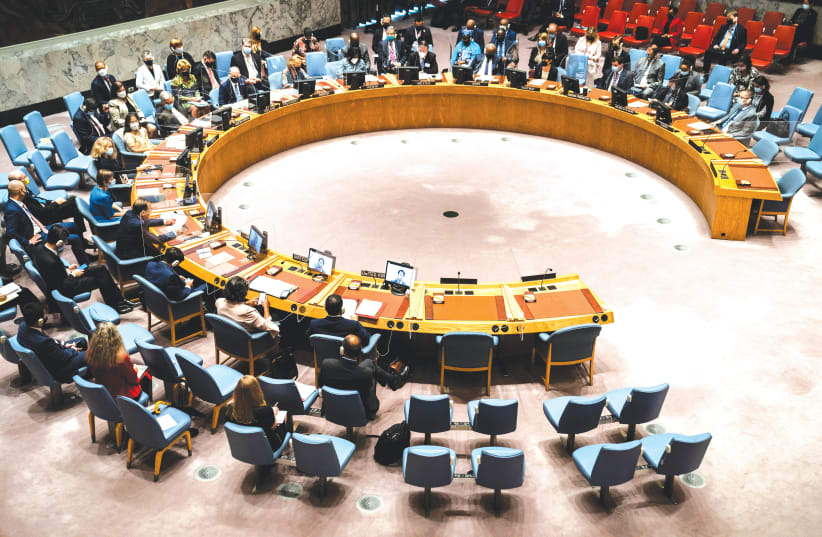This week, 54 years ago, November 22, 1967, the United Nations Security Council unanimously adopted Resolution 242. This resolution aimed to bring about “a just and lasting peace,” in the Middle East following the Six Day War five months earlier, where Israel managed to capture territory from its neighbors in a war of self-defense. Resolution 242 has been frequently misquoted by Israel’s detractors, who claim that it demands that Israel withdraw from all the territories it captured and that it cannot draw new boundaries. However, a proper legal interpretation and analysis of the resolution shows that the exact opposite holds true.
An argument that has been put forward by detractors of Israel is that the phrase “inadmissibility of the acquisition of territory by war” in Resolution 242’s preamble precludes Israel from holding onto any territory it captured in war. Yet, according to an International Court of Justice (ICJ) ruling, preambles of League of Nations resolutions are non-binding and only the operative sections enshrine legal obligations.
This ruling has been transferred over from the League of Nations to the United Nations. Given that the drafters of Resolution 242 placed this phrase in the preamble as opposed to the operative paragraphs below it, the drafters avoided putting any prohibitions on Israel from being entitled to new boundaries past the 1949 armistice lines. Furthermore, international law makes a distinction between the acquisition of territory through aggression versus self-defense. Stephen Schwebel, a former president of the ICJ, stated that, “the facts of the June 1967 ‘Six Day War’ demonstrate that Israel reacted defensively against the threat and use of force against her.” Considering this, Schwebel commented that, “A state [Israel] acting in lawful exercise of its right of self-defense may seize and occupy foreign territory as long as such seizure and occupation are necessary to its self-defense.”
The primary phrase of Resolution 242 that Israel’s detractors rely on is Paragraph 1(i) which states, “withdrawal of Israel armed forces from territories occupied in the recent conflict.” However, Resolution 242 didn’t include the word “the” before “territories,” which indicates that it didn’t mandate Israel to withdraw from all of the territories. This has been confirmed by the drafters of Resolution 242. For instance, Arthur Goldberg, the US ambassador to the UN and a key drafter of Resolution 242 commented: “The notable omissions in language used to refer to withdrawal are the words ‘the,’ ‘all,’ and the ‘June 5, 1967 lines.’ I refer to the English text of the resolution. The French and Soviet texts differ from the English in this respect, but the English text was voted on by the Security Council, and thus it is determinative. In other words, there is lacking a declaration requiring Israel to withdraw from the (or all the) territories occupied by it on and after June 5, 1967.”
Eugene Rostow, who was US undersecretary of state in 1967 and a drafter of Resolution 242, affirmed this by commenting on Paragraph 1(i): “Repeated attempts to amend this sentence by inserting the word ‘the’ failed in the Security Council. It is, therefore, not legally possible to assert that the provision requires Israeli withdrawal from all the territories.” The Soviets tried to insert a clause that would require Israel to withdraw to the prewar lines, but this language was rejected. The Soviet deputy foreign minister Vasily Kuznetsov conceded “there is certainly much leeway for different interpretations that retain for Israel the right to establish new boundaries and to withdraw its troops only so far as the lines it judges convenient.”
Instead of withdrawing from all the territory, Rostow explained that Resolution 242, “allows Israel to administer the territories it occupied in 1967 until ‘a just and lasting peace in the Middle East’ is achieved. When such a peace is made, Israel is required to withdraw its armed forces ‘from territories’ it occupied during the Six Day War – not from ‘the’ territories nor from ‘all’ the territories, but from some of the territories.”
While Israel could have to withdraw from some of the territories as part of a negotiated peace, Resolution 242 also entitles Israel to new defensible borders to replace the 1949 armistice lines. The armistice lines were delineated in the armistice agreements that Israel signed with its neighbors in 1949, each of which stated that these lines would not constitute internationally recognized borders. Rostow stated that, “Resolution 242 is based on that provision of the Armistice Agreements and states certain criteria that would justify changes in the demarcation lines when the parties make peace.” This can be observed under Paragraph 1(ii) of Resolution 242 which recognizes “the right to live in peace within secure and recognized boundaries free from threats or acts of force.”
Ambassador Goldberg clarified that “it can be inferred from the incorporation of the words ‘secure and recognized boundaries that the territorial adjustments to be made by the parties in their peace settlements could encompass less than a complete withdrawal of Israeli forces.” Additionally, Lord Caradon, the British ambassador to the UN in 1967 and the chief drafter of Resolution 242, which was submitted by Britain, repeatedly reiterated that Resolution 242 doesn’t require that Israel return to the 1949 armistice lines and that new boundaries should be created. For instance, in an interview given with the Beirut Daily Star in 1974, Caradon explained, “it would have been wrong to demand that Israel return to its position of 4 June 1967 because those positions were undesirable and artificial... They were just armistice lines.”
In summation, nothing in Resolution 242 requires Israel to withdraw from all the territories.
The writer graduated last year from Widener University School of Law, Harrisburg, PA campus.

